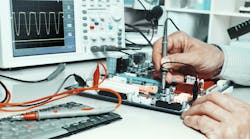Test and Debug Your Circuit Design for EMI Compliance
This article is part of the TechXchange: Delving into EMI, EMC and Noise
Members can download this article in PDF format.
What you'll learn:
- What is the Conducted EMI measurement?
- Using FFT-based measuring receivers for CISPR 32.
- Combining debugging and pre-compliance modes in test equipment.
EMC compliance testing of a manufacturer’s product can be quite costly and time-consuming, especially if the initial submission of the product fails at the test house, leading to the manufacturer fixing the problem and resubmitting for EMC testing. One obvious solution to reduce compliance costs is to perform basic pre-compliance measurement(s) and debugging at the manufacturer’s facility before submitting to an EMC test house.
Conducted EMI Measurement
The Conducted EMI measurement,1 a critical EMC compliance measurement, can be performed fairly easily at the manufacturer’s location. Amazingly, all that’s needed is a basic oscilloscope and cloud computing.
As compared with a test house, the manufacturer’s facility will probably be a noisy environment in which to perform the conducted EMI measurement. However, the conducted EMI measurement is done at frequencies from 150 kHz to 30 MHz, where conducted emission is dominant.
The main path for interfering EMI getting through will be the connection between the equipment under test (EUT) and the power supply. It will be possible to perform this conducted EMI measurement on the manufacturing site as long as there’s a good separation between the power supply and EUT. An EMI separation device must be used to separate the power supply from the EUT (see figure).
The EMI separation device contains an enhanced EMI filter that’s able to provide 62- to 82-dB attenuation for common-mode EMI and 78- to 90-dB attenuation for differential-mode EMI at frequencies spanning 150 kHz to 30 MHz. After the EMI separation device, the environmental noise will be 15 dB below the limitation line given by the EMC regulation, which satisfies the environment noise requirement for a standard conducted EMI measurement.
An even less-expensive way to conduct this EMI measurement, without an EMI receiver, is an app developed in Reference 1. Running in a smartphone, it controls a general oscilloscope that measures EMI of the EUT through the EMI separation device. The EMI data can then be automatically uploaded to the cloud for further treatment (Reference 1 has all of the details).
FFT-Based Measuring Receivers for EMI Compliance Measurements Against CISPR 32
Users of CISPR 322 can immediately employ a fast-Fourier-transformer-based (FFT) measuring receiver for EMI compliance measurements if the instrument meets the requirements of CISPR 16-1-1. Two different types of FFT-based receivers are available:
- Instruments that digitize the input signal with an analog-to-digital converter (ADC) in the baseband.
- Instruments that digitize the signal with an ADC at the output of the wideband IF filter.
Comparing conventional EMI receiver measurements (single frequency) and FFT-based time-domain scanning has proven that these results are identical.
Using pre-selection filters is necessary for maximum dynamic range and to avoid overload. This is particularly true for quasi-peak measurements of weak pulsed signals in the presence of high-amplitude carriers.
Trends in EMI Pre-Compliance Debugging
The latest test instruments frequently combine debugging and pre-compliance modes to help engineers save valuable time and resources in their design process.4
Engineers need to visualize and resolve more issues as early in the design as possible. This requires flexible solutions that can capture and visualize any issues across digital, analog, and RF domains. Besides traditional EMI pre-compliance scanning, there are new solutions that make it possible to capture emissions in real-time, debug EMI in the time domain, and combine all of these capabilities in the multi-domain analysis.
EMI pre-compliance measurements give valuable feedback to engineers all throughout the design process. Flexible real-time spectrum and time-domain analysis for multi-domain debugging will enable designers to discover issues faster and solve complex problems on the bench. This effort will lead to faster time to market, allow for real-time debugging, and build more confidence in a design as a project moves toward final EMI compliance testing in a more timely manner.
Summary
Companies need to enable speed and efficiency throughout the electronic design process. A big part of enabling faster time to market is conducting pre-compliance testing on the same test bench where debugging RF and embedded signals take place. Using the latest instruments that can combine pre-compliance modes and debugging will enable designers to quicken product turnaround.
Read more articles in the TechXchange: Delving into EMI, EMC and Noise
References
1. “Low Cost Conducted EMI Measurement on Site for Product EMC Pre-compliance,” IEEE 2019.
2. “Use of FFT-based measuring receivers for EMI compliance measurements against CISPR 32,” 2017 Asia-Pacific International Symposium on Electromagnetic Compatibility (APEMC), June 20-23, 2017, Seoul, Korea.
3. “LCL Filter Design and Analysis of Grid-Connected Converter for Power Quality and EMI Compliance,” 7th Asia Pacific International Symposium on Electromagnetic Compatibility, IEEE 2016
4. 2021 Power Electronics Guide by Interference Technology


